Ratiometric Fluorescence Probe Based on Deep-Red Emissive CdTe Quantum Dots and Eu3+ Hybrid for Oxytetracycline Detection
Abstract
:1. Introduction
2. Experimental
2.1. Materials and Instrumentation
2.2. Synthesis of CdTe QDs
2.3. OTC Detection
2.4. OTC Recovery Experiment
3. Results and Discussion
3.1. Characterization of CdTe QDs
3.2. Ratiometric Fluorometric Detection for OTC
3.3. Mechanism of OTC Detection
3.4. Time and pH-Dependent Response
3.5. Selectivity and Anti-Interference
3.6. Real Samples Analysis
4. Conclusions
Supplementary Materials
Author Contributions
Funding
Institutional Review Board Statement
Informed Consent Statement
Data Availability Statement
Acknowledgments
Conflicts of Interest
References
- Zhao, Y.; Ong, S.; Chen, Y.; Huang, P.-J.J.; Liu, J. Label-free and Dye-free Fluorescent Sensing of Tetracyclines Using a Capture-Selected DNA Aptamer. Anal. Chem. 2022, 94, 10175–10182. [Google Scholar] [CrossRef] [PubMed]
- Chern, M.; Garden, P.M.; Baer, R.C.; Galagan, J.E.; Dennis, A.M. Transcription Factor Based Small-Molecule Sensing with a Rapid Cell Phone Enabled Fluorescent Bead Assay. Angew. Chem. Int. Ed. 2020, 59, 21597–21602. [Google Scholar] [CrossRef] [PubMed]
- Wang, S.; Sun, M.Y.; Zhang, Y.H.; Li, H.; Zhang, Y.H.; Li, H.; Gao, J.W.; Song, S.; Sun, J.; Liu, H.; et al. Ultrasensitive antibiotic perceiving based on aptamer-functionalized ultraclean graphene field-effect transistor biosensor. Anal. Chem. 2022, 94, 14785–14793. [Google Scholar] [CrossRef] [PubMed]
- Li, Y.; Wang, Y.; Du, P.; Zhang, L.; Liu, Y.; Lu, X. Fabrication of carbon dots@hierarchical mesoporous ZIF-8 for simultaneous ratiometric fluorescence detection and removal of tetracycline antibiotics. Sens. Actuators B Chem. 2022, 358, 131526. [Google Scholar] [CrossRef]
- Zong, L.-P.; Li, J.; Shu, G.; Liu, X.; Marks, R.S.; Zhang, X.-J.; Cosnier, S.; Shan, D. Rational Design of a Highly Dispersed Fe–N–C Nanosheet with 1,10-Phenanthroline-2,9-Dicarboxylic Acid as a Preorganized Ligand: Boosted Electrochemiluminescence Detection of Tetracycline. Anal. Chem. 2022, 94, 1325–1332. [Google Scholar] [CrossRef]
- Zhao, W.; Dai, B.L.; Zhu, F.X.; Tu, X.Y.; Xu, J.M.; Zhang, L.L.; Li, S.Y.; Leung, D.Y.C.; Sun, C. A novel 3D plasmonic p-n heterojunction photocatalyst: Ag nanoparticles on flower-like p-Ag2S/n-BiVO4 and its excellent photocatalytic reduction and oxidation activities. Appl. Catal. B Environ. 2018, 229, 171–180. [Google Scholar]
- Liu, B.; Zheng, S.; Li, H.; Xu, J.; Tang, H.; Wang, Y.; Wang, Y.; Sun, F.; Zhao, X. Ultrasensitive and facile detection of multiple trace antibiotics with magnetic nanoparticles and core-shell nanostar SERS nanotags. Talanta 2022, 237, 122955. [Google Scholar] [CrossRef]
- Wang, X.Y.; Rong, X.J.; Zhang, Y.; Luo, F.; Qiu, B.; Wang, J.; Lin, Z.Y. Homogeneous photoelectrochemical aptasensors for tetracycline based on sulfur-doped g-C3N4/n-GaN heterostructures formed through self-assembly. Anal. Chem. 2022, 94, 3735–3742. [Google Scholar] [CrossRef]
- Li, X.; Hu, Q.; Yang, K.; Zhao, S.; Zhu, S.; Wang, B.; Zhang, Y.; Yi, J.; Song, X.; Lan, M. Red fluorescent carbon dots for sensitive and selective detection and reduction of Au3+. Sens. Actuators B Chem. 2022, 371, 132534. [Google Scholar] [CrossRef]
- Li, X.; Xing, X.; Zhao, S.; Zhu, S.; Wang, B.; Lan, M.; Song, X. Carbon dot-based fluorescent and colorimetric sensor for sensitive and selective visual detection of benzoyl peroxide. Chin. Chem. Lett. 2022, 33, 1632. [Google Scholar] [CrossRef]
- Dou, W.-T.; Han, H.-H.; Sedgwick, A.C.; Zhu, G.-B.; Zang, Y.; Yang, X.-R.; Yoon, J.; James, T.D.; Li, J.; He, X.-P. Fluorescent probes for the detection of disease-associated biomarkers. Sci. Bull. 2022, 67, 853–878. [Google Scholar] [CrossRef]
- Wang, J.; Zhang, Q.; Liu, Z.; Yang, C.; Li, Y.; Ma, X.; Lv, T.; Sun, C. Label-Free Fluorescence Sensing Strategy Based on Functional Nucleic Acids via Energy Transfer between DNA-Templated Silver Nanoclusters and Gold Nanorods. J. Agric. Food Chem. 2022, 70, 12220–12231. [Google Scholar] [CrossRef]
- Wang, X.; Li, L.; Jiang, H.; Zhangsun, H.; Wang, Q.; Sun, X.; Wang, L. Highly selective and sensitive fluorescence detection of tetracyclines based on novel tungsten oxide quantum dots. Food Chem. 2022, 374, 131774. [Google Scholar] [CrossRef]
- Huang, C.Y.; Luo, Y.X.; Li, J.C.; Liu, C.; Zhou, T.S.; Deng, J.J. pH-regulated H4TCPE@Eu/AMP ICP sensor array and its fingerprinting on test papers: Toward point-of-use systematic analysis of environmental antibiotics. Anal. Chem. 2021, 93, 9183–9192. [Google Scholar] [CrossRef]
- Zhuang, Q.; Zhang, C.; Zhuang, H.; Deng, H.; Lin, X.; Li, Y.; Chen, H.; Xie, A.; Dong, W. Heteroatom-free conjugated tetraphenylethylene polymers for selectively fluorescent detection of tetracycline. Anal. Chim. Acta 2022, 1190, 339236. [Google Scholar] [CrossRef]
- Yan, Y.; Liu, J.H.; Li, R.S.; Li, Y.F.; Huang, C.Z.; Zhen, S.J. Carbon dots synthesized at room temperature for detection of tetracycline hydrochloride. Anal. Chim. Acta 2019, 1063, 144–151. [Google Scholar] [CrossRef]
- Liu, L.; Chen, Q.; Lv, J.; Li, Y.P.; Wang, K.C.; Li, J.R. Stable meta-organic frameworks for fluorescent detection of tetracycline antibiotics. Inorg. Chem. 2022, 61, 8015–8021. [Google Scholar] [CrossRef]
- Chen, B.-B.; Liu, M.-L.; Gao, Y.-T.; Chang, S.; Qian, R.-C.; Li, D.-W. Design and applications of carbon dots-based ratiometric fluorescent probes: A review. Nano Res. 2022, 1–20. [Google Scholar] [CrossRef]
- Wang, K.; Liu, L.; Mao, D.; Xu, S.; Tan, C.; Cao, Q.; Mao, Z.; Liu, B. A Polarity-Sensitive Ratiometric Fluorescence Probe for Monitoring Changes in Lipid Droplets and Nucleus during Ferroptosis. Angew. Chem. Int. Ed. 2021, 60, 15095–15100. [Google Scholar] [CrossRef]
- Park, S.-H.; Kwon, N.; Lee, J.-H.; Yoon, J.; Shin, I. Synthetic ratiometric fluorescent probes for detection of ions. Chem. Soc. Rev. 2020, 49, 143–179. [Google Scholar] [CrossRef]
- Li, X.; Zhao, S.; Li, B.; Yang, K.; Lan, M.; Zeng, L. Advances and perspectives in carbon dot-based fluorescent probes: Mechanism, and application. Co-Ord. Chem. Rev. 2021, 431, 213686. [Google Scholar] [CrossRef]
- Lee, T.; Enomoto, K.; Ohshiro, K.; Inoue, D.; Kikitsu, T.; Hyeon-Deuk, K.; Pu, Y.-J.; Kim, D. Controlling the dimension of the quantum resonance in CdTe quantum dot superlattices fabricated via layer-by-layer assembly. Nat. Commun. 2020, 11, 5471. [Google Scholar] [CrossRef] [PubMed]
- Jiang, R.; Lin, D.; Zhang, Q.; Li, L.; Yang, L. Multiplex chroma-response based fluorescent smartphone sensing platform for rapid and visual quantitative determination of antibiotic residues. Sens. Actuators B Chem. 2022, 350, 130902. [Google Scholar] [CrossRef]
- Liu, Q.; Lin, Y.; Xiong, J.; Wu, L.; Hou, X.; Xu, K.; Zheng, C. Disposable Paper-Based Analytical Device for Visual Speciation Analysis of Ag(I) and Silver Nanoparticles (AgNPs). Anal. Chem. 2019, 91, 3359–3366. [Google Scholar] [CrossRef] [PubMed]
- Hua, M.; Yang, S.; Ma, J.; He, W.; Kuang, L.; Hua, D. Highly selective and sensitive determination of uranyl ion by the probe of CdTe quantum dot with a specific size. Talanta 2018, 190, 278–283. [Google Scholar] [CrossRef]
- Fan, Y.; Che, S.Y.; Zhang, L.; Zhou, C.S.; Fu, H.Y.; She, Y.B. Highly sensitive visual fluorescence sensor for aminoglycoside antibiotics in food samples based on mercaptosuccinic acid-CdTe quantum dots. Food Chem. 2023, 404, 134040. [Google Scholar] [CrossRef]
- Wang, Q.; Li, X.; Yang, K.; Zhao, S.; Zhu, S.; Wang, B.; Yi, J.; Zhang, Y.; Song, X.; Lan, M. Carbon Dots and Eu3+ Hybrid-Based Ratiometric Fluorescent Probe for Oxytetracycline Detection. Ind. Eng. Chem. Res. 2022, 61, 5825–5832. [Google Scholar] [CrossRef]
- Xu, D.; Chen, W.; Zeng, M.; Xue, H.; Chen, Y.; Sang, X.; Xiao, Y.; Zhang, T.; Unocic, R.R.; Xiao, K.; et al. Crystal-Field Tuning of Photoluminescence in Two-Dimensional Materials with Embedded Lanthanide Ions. Angew. Chem. Int. Ed. 2018, 57, 755–759. [Google Scholar] [CrossRef]
- Wang, Y.; Li, B.; Song, X.; Shen, R.; Wang, D.; Yang, Y.; Feng, Y.; Cao, C.; Zhang, G.-L.; Liu, W. Mito-Specific Ratiometric Terbium(III)-Complex-Based Luminescent Probe for Accurate Detection of Endogenous Peroxynitrite by Time-Resolved Luminescence Assay. Anal. Chem. 2019, 91, 12422–12427. [Google Scholar] [CrossRef]
- Fu, Y.; Wu, S.; Zhou, H.; Zhao, S.; Lan, M.; Huang, J.; Song, X. Carbon Dots and a CdTe Quantum Dot Hybrid-Based Fluorometric Probe for Spermine Detection. Ind. Eng. Chem. Res. 2020, 59, 1723–1729. [Google Scholar] [CrossRef]
- Anand, S.K.; Sivasankaran, U.; Jose, A.R.; Kumar, K.G. Interaction of tetracycline with l-cysteine functionalized CdS quantum dots-Fundamentals and sensing application. Spectrochim. Acta Part A Mol. Biomol. Spectrosc. 2019, 213, 410–415. [Google Scholar] [CrossRef]
- Qian, S.; Qiao, L.; Xu, W.; Jiang, K.; Wang, Y.; Lin, H. An inner filter effect-based near-infrared probe for the ultrasensitive detection of tetracyclines and quinolones. Talanta 2019, 194, 598–603. [Google Scholar] [CrossRef]
- Liu, G.-N.; Xu, R.-D.; Zhao, R.-Y.; Sun, Y.; Bo, Q.-B.; Duan, Z.-Y.; Li, Y.-H.; Wang, Y.-Y.; Wu, Q.; Li, C. Hybrid Copper Iodide Cluster-Based Pellet Sensor for Highly Selective Optical Detection of o-Nitrophenol and Tetracycline Hydrochloride in Aqueous Solution. ACS Sustain. Chem. Eng. 2019, 7, 18863–18873. [Google Scholar] [CrossRef]
- Wang, T.; Mei, Q.; Tao, Z.; Wu, H.; Zhao, M.; Wang, S.; Liu, Y. A smartphone-integrated ratiometric fluorescence sensing platform for visual and quantitative point-of-care testing of tetracycline. Biosens. Bioelectron. 2020, 148, 111791. [Google Scholar] [CrossRef]
- Shi, C.; Qi, H.; Ma, R.; Sun, Z.; Xiao, L.; Wei, G.; Huang, Z.; Liu, S.; Li, J.; Dong, M.; et al. N,S-self-doped carbon quantum dots from fungus fibers for sensing tetracyclines and for bioimaging cancer cells. Mater. Sci. Eng. C 2019, 105, 110132. [Google Scholar] [CrossRef]
- Yao, R.; Li, Z.; Huo, P.; Gong, C.; Li, J.; Fan, C.; Pu, S. A Eu3+-based high sensitivity ratiometric fluorescence sensor for determination of tetracycline combining bi-functional carbon dots by surface functionalization and heteroatom doping. Dye. Pigment. 2022, 201, 110190. [Google Scholar] [CrossRef]
- Yan, F.; Sun, Z.; Pang, J.; Jiang, Y.; Zheng, W. Functionalized carbon dots of thiazole derivatives based on inner filter effect for tetracyclines detection. Dye. Pigment. 2020, 183, 108673. [Google Scholar] [CrossRef]
- Li, L.; Shi, L.; Jia, J.; Eltayeb, O.; Lu, W.; Tang, Y.; Dong, C.; Shuang, S. Red fluorescent carbon dots for tetracycline antibiotics and pH discrimination from aggregation-induced emission mechanism. Sens. Actuators B Chem. 2021, 332, 129513. [Google Scholar] [CrossRef]
- Han, L.; Fan, Y.Z.; Qing, M.; Liu, S.G.; Yang, Y.Z.; Li, N.B.; Luo, H.Q. Smartphones and Test Paper-Assisted Ratiometric Fluorescent Sensors for Semi-Quantitative and Visual Assay of Tetracycline Based on the Target-Induced Synergistic Effect of Antenna Effect and Inner Filter Effect. ACS Appl. Mater. Interfaces 2020, 12, 47099–47107. [Google Scholar] [CrossRef] [PubMed]
- Xing, X.; Huang, L.; Zhao, S.; Xiao, J.; Lan, M. S,N-Doped carbon dots for tetracyclines sensing with a fluorometric spectral response. Microchem. J. 2020, 157, 105065. [Google Scholar] [CrossRef]
- Zhang, Z.; Fan, Z. Application of cerium–nitrogen co-doped carbon quantum dots to the detection of tetracyclines residues and bioimaging. Microchem. J. 2021, 165, 106139. [Google Scholar] [CrossRef]
- Shen, Z.; Zhang, C.; Yu, X.; Li, J.; Wang, Z.; Zhang, Z.; Liu, B. Microwave-assisted synthesis of cyclen functional carbon dots to construct a ratiometric fluorescent probe for tetracycline detection. J. Mater. Chem. C 2018, 6, 9636–9641. [Google Scholar] [CrossRef]
- Zhang, S.; Sun, Q.; Liu, X.; Li, H.; Wang, J.; Chen, M. Ratiometric fluorescence detection of tetracycline for tetracycline adjuvant screening in bacteria. Sens. Actuators B Chem. 2022, 372, 132687. [Google Scholar] [CrossRef]
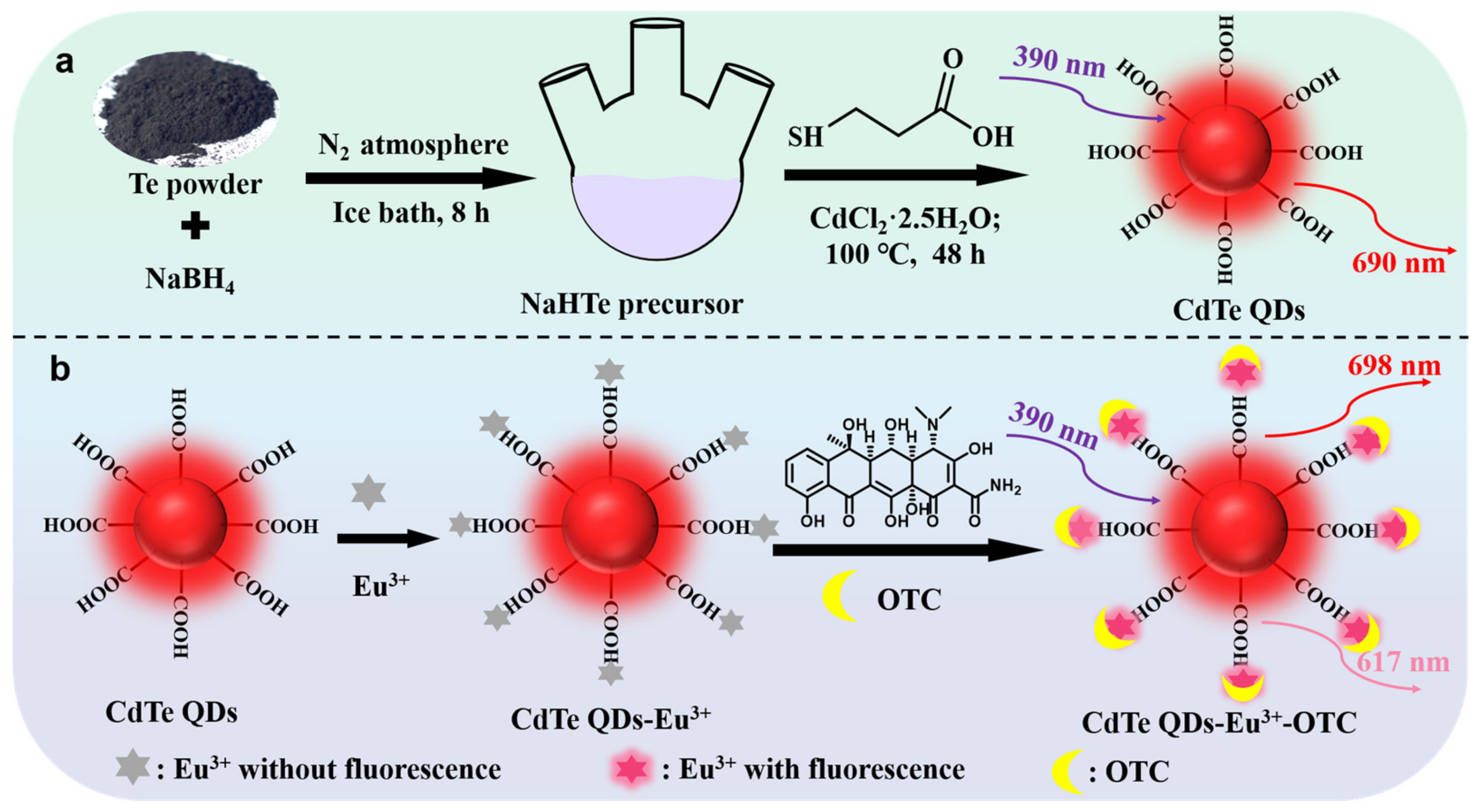
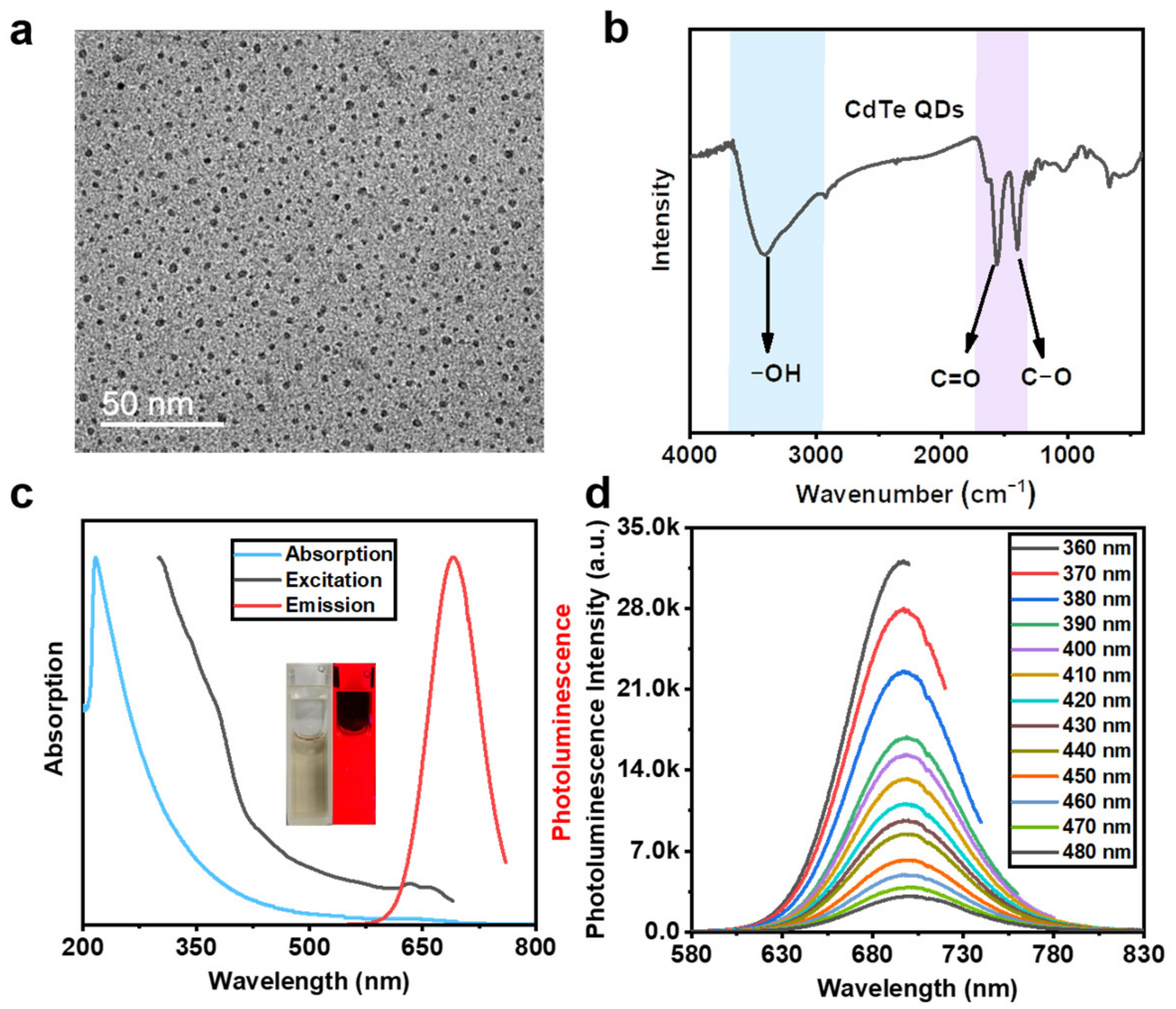
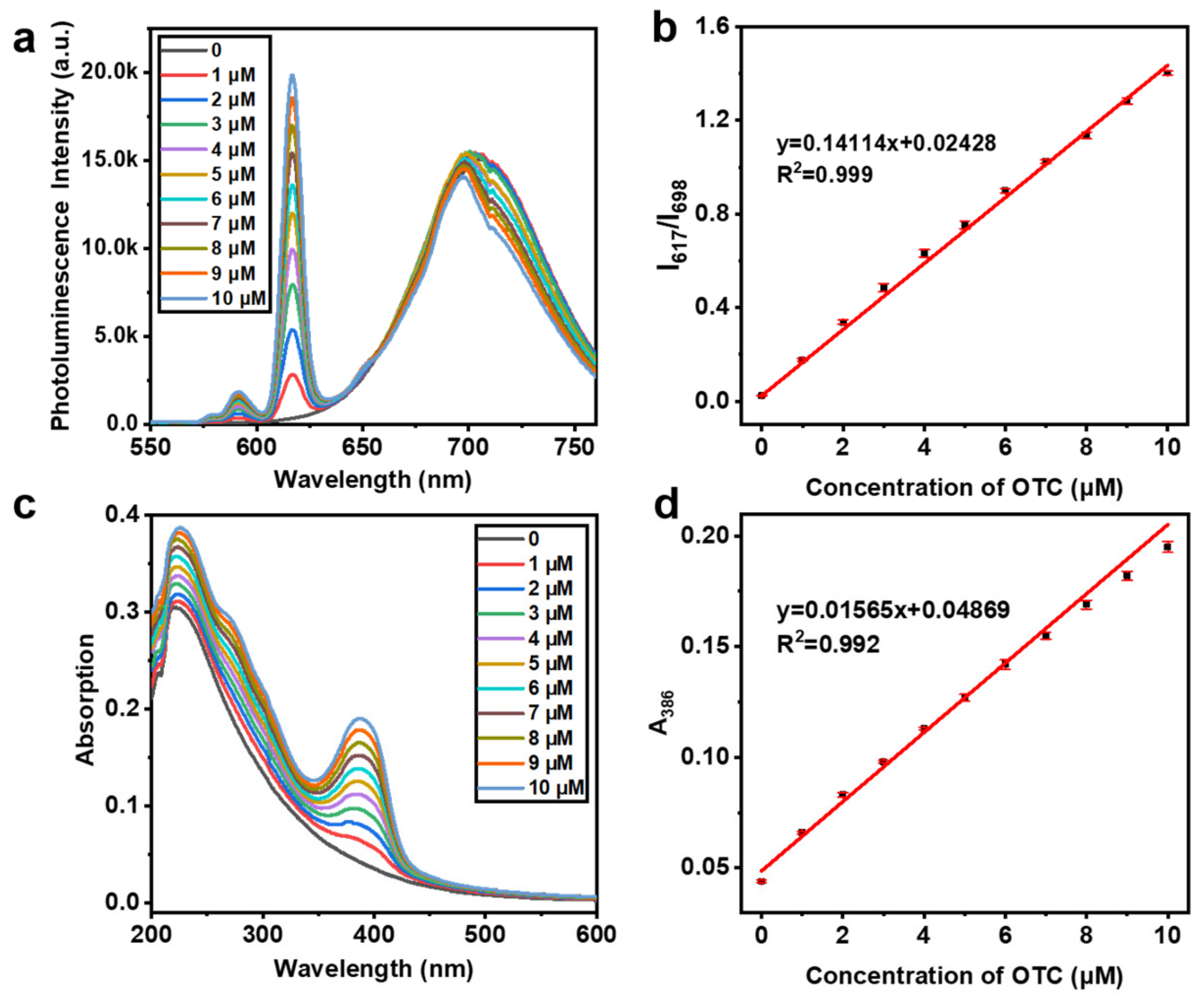
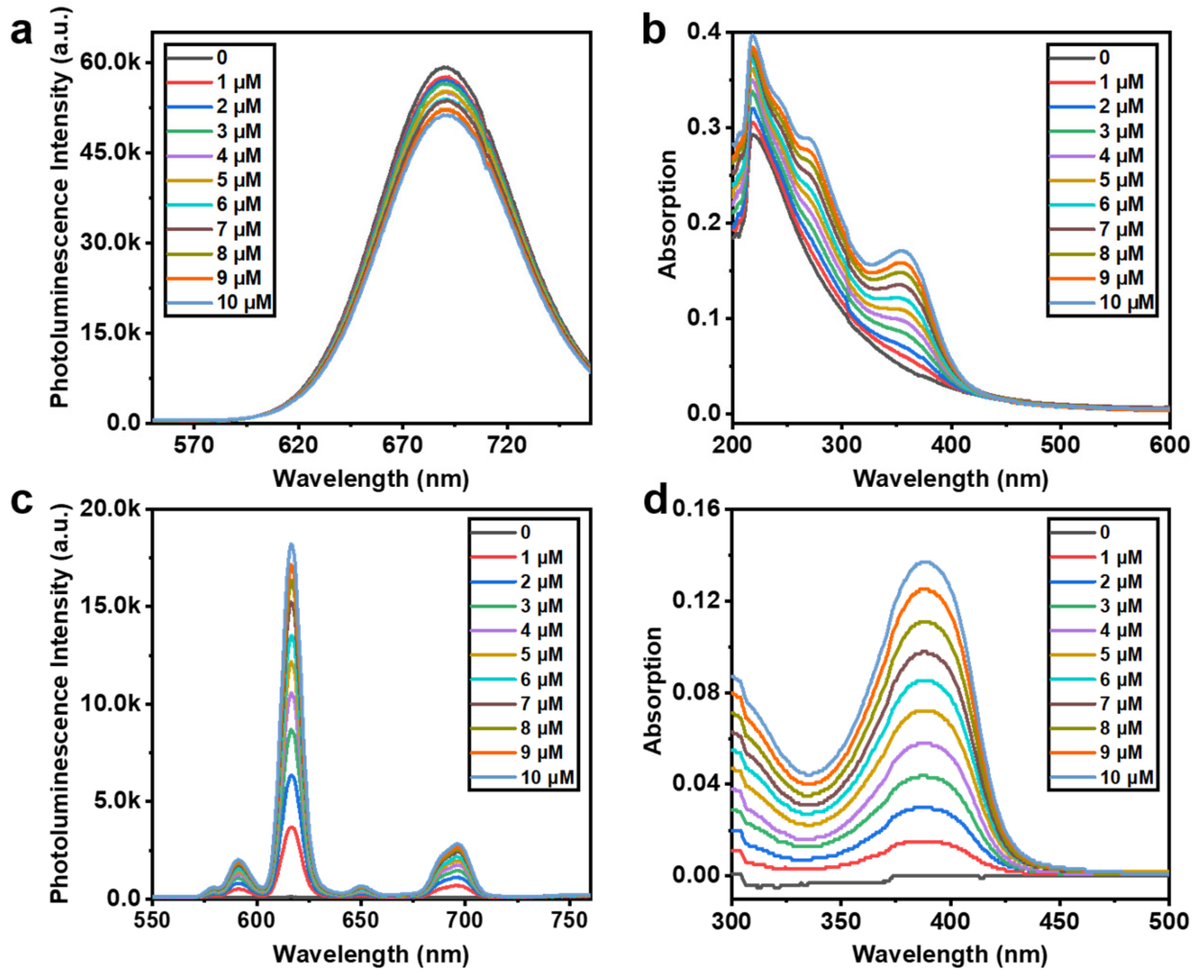

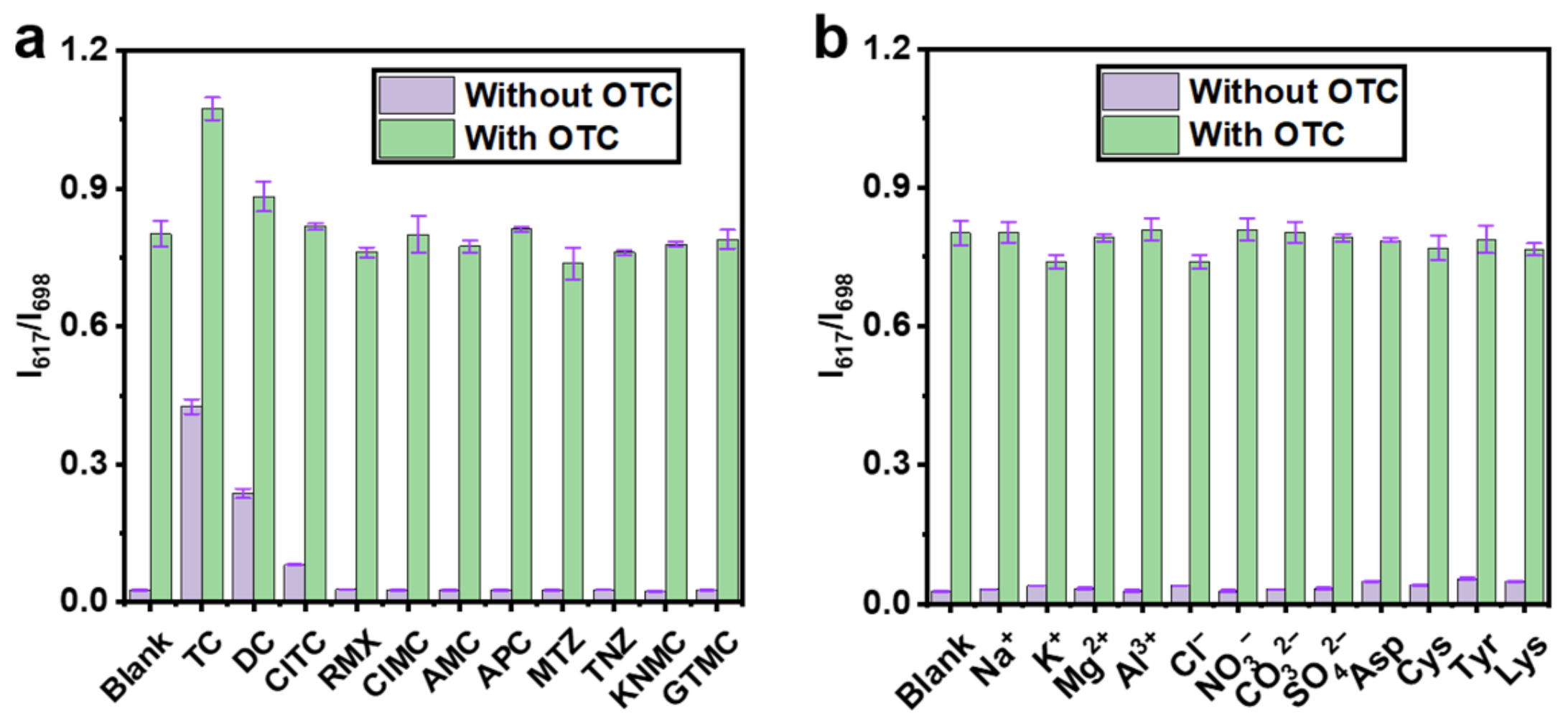
| Probe | Fluorescence Signal | Analyte | Wavelength (nm) | Time (min) | LOD (nM) | Reference |
|---|---|---|---|---|---|---|
| CdS QDs | Turn off | TC | 535 | 5 | 7.78 | [31] |
| NIR-CDs | Turn off | TC, OTC, DC, ClTC | 680 | 60 | 500 | [32] |
| UJN-Cu2 | Turn off | TC | 578 | None | 2.30 × 103 | [33] |
| DPA-Ce-GMP-Eu | Ratiometric | TC | 415; 615 | 2 | 6.6 | [34] |
| N,S-CDs | Turn off | TC, ClTC, OTC, | 440 | None | 15.6, 36.4, 40.7 | [35] |
| Cu-CDs–COOH–Eu | Ratiometric | TC | 467, 625 | 1 | 36.1 | [36] |
| CDs-AP | Turn off | TC | 488 | 10 | 0.7 | [37] |
| R-CDs | Turn on | TC, OTC, ClTC | 612 | 2 | 12, 23, 25 | [38] |
| g-C3N4/Eu3+ | Ratiometric | TC | 441, 618 | 10 | 6.5 | [39] |
| S,N-CDs | Turn off | TC, DC, OTC | 440 | 0.5 | 250, 390, 260 | [40] |
| Ce-N-CDs | Turn off | DC | 440 | 5 | 250 | [41] |
| CdTe QDs-Eu3+ | Ratiometric | OTC | 617, 698 | 0.67 | 5.4 | This work |
| Practical Samples | Added (μM) | Detected (μM) | Recovery (%) | RSD (n = 3) |
|---|---|---|---|---|
| River water | 3 | 3.04 | 101.3 | 0.046 |
| 5 | 5.19 | 103.8 | 0.145 | |
| 8 | 7.51 | 93.9 | 0.176 | |
| Tap water | 3 | 3.37 | 112.3 | 0.141 |
| 5 | 5.15 | 103.0 | 0.095 | |
| 8 | 7.73 | 96.6 | 0.130 |
Disclaimer/Publisher’s Note: The statements, opinions and data contained in all publications are solely those of the individual author(s) and contributor(s) and not of MDPI and/or the editor(s). MDPI and/or the editor(s) disclaim responsibility for any injury to people or property resulting from any ideas, methods, instructions or products referred to in the content. |
© 2023 by the authors. Licensee MDPI, Basel, Switzerland. This article is an open access article distributed under the terms and conditions of the Creative Commons Attribution (CC BY) license (https://creativecommons.org/licenses/by/4.0/).
Share and Cite
Tan, S.; Wang, Q.; Tan, Q.; Zhao, S.; Huang, L.; Wang, B.; Song, X.; Lan, M. Ratiometric Fluorescence Probe Based on Deep-Red Emissive CdTe Quantum Dots and Eu3+ Hybrid for Oxytetracycline Detection. Chemosensors 2023, 11, 62. https://doi.org/10.3390/chemosensors11010062
Tan S, Wang Q, Tan Q, Zhao S, Huang L, Wang B, Song X, Lan M. Ratiometric Fluorescence Probe Based on Deep-Red Emissive CdTe Quantum Dots and Eu3+ Hybrid for Oxytetracycline Detection. Chemosensors. 2023; 11(1):62. https://doi.org/10.3390/chemosensors11010062
Chicago/Turabian StyleTan, Siyi, Qin Wang, Qiuxia Tan, Shaojing Zhao, Lei Huang, Benhua Wang, Xiangzhi Song, and Minhuan Lan. 2023. "Ratiometric Fluorescence Probe Based on Deep-Red Emissive CdTe Quantum Dots and Eu3+ Hybrid for Oxytetracycline Detection" Chemosensors 11, no. 1: 62. https://doi.org/10.3390/chemosensors11010062
APA StyleTan, S., Wang, Q., Tan, Q., Zhao, S., Huang, L., Wang, B., Song, X., & Lan, M. (2023). Ratiometric Fluorescence Probe Based on Deep-Red Emissive CdTe Quantum Dots and Eu3+ Hybrid for Oxytetracycline Detection. Chemosensors, 11(1), 62. https://doi.org/10.3390/chemosensors11010062





